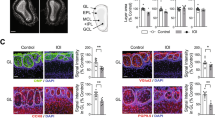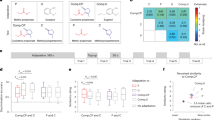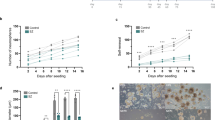Abstract
Olfactory impairments are a common feature of schizophrenia. Impairments in odor detection and odor identification are present early in the course of illness and among those at risk for the disorder. These behavioral impairments have been linked to both physiological and anatomical abnormalities in the neural substrates subserving olfaction, including relatively peripheral elements of the olfactory system. The location of olfactory receptor neurons in the nasal epithelium allows noninvasive access to these neurons in living subjects. This offers a unique opportunity to directly assess neuronal integrity in vivo in patients. The peripheral olfactory receptor neuron response to odor stimulation was assessed in 21 schizophrenia patients and 18 healthy comparison subjects. The electroolfactogram, representing the electrical depolarization of the olfactory receptor neurons, was recording following stimulation with different doses and durations of hydrogen sulfide, a pure olfactory nerve stimulant. Schizophrenia patients had abnormally large depolarization responses following odor stimulation, independent of clinical symptomatology, antipsychotic medication dosage or smoking history. Although the precise pathophysiological mechanism is unknown, this olfactory receptor neuron abnormality is consistent with several lines of evidence suggesting altered proliferation or maturation of olfactory receptor neuron cell lineages in schizophrenia. It is also consistent with emerging evidence of disruptions of cyclic AMP-mediated intracellular signaling mechanisms, and may be a marker of these disruptions. It unambiguously demonstrates that neurophysiological disturbances in schizophrenia are not limited to cortical and subcortical structures, but rather include even the most peripheral sensory neurons.
Similar content being viewed by others
Log in or create a free account to read this content
Gain free access to this article, as well as selected content from this journal and more on nature.com
or
References
Andreasen NC (1983). The Scale for the Assessment of Negative Symptoms (SANS). The University of Iowa: Iowa City, IA.
Andreasen NC (1984). The Scale for the Assessment of Positive Symptoms (SAPS). The University of Iowa: Iowa City, IA.
Arnold SE, Han LY, Moberg PJ, Turetsky BI, Gur RE, Trojanowski JQ et al (2001). Dysregulation of olfactory receptor neuron lineage in schizophrenia. Arch Gen Psychiatry 58: 829–835.
Brewer WJ, Wood SJ, McGorry PD, Francey SM, Phillips LJ, Yung AR et al (2003). Impairment of olfactory identification ability in individuals at ultra-high risk for psychosis who later develop schizophrenia. Am J Psychiatry 160: 1790–1794.
Chetkovich DM, Sweatt JD (1993). NMDA receptor activation increases cyclic AMP in area CA1 of the hippocampus via calcium/calmodulin stimulation of adenylyl cyclase. J Neurochem 61: 1933–1942.
Dluzen DE, Kreutzberg JD (1996). Norepinephrine is lateralized within the olfactory bulbs of male mice. J Neurochem 66: 1222–1226.
Doty RL, Bromley SM, Moberg PJ, Hummel T (1997). Laterality in human nasal chemoreception. In: Christman S (ed). Cerebral Asymmetries in Sensory and Perceptual Processing. North-Holland: Amsterdam. pp 497–542.
Doty RL, Shaman P, Applebaum SL, Giberson R, Siksorski L, Rosenberg L (1984). Smell identification ability: changes with age. Science 226: 1441–1443.
Féron F, Perry C, Hirning MH, McGrath J, Mackay-Sim A (1999). Altered adhesion, proliferation and death in neural cultures from adults with schizophrenia. Schizophr Res 40: 211–218.
Gesteland RC, Yancey RA, Farbman AI (1982). Development of olfactory receptor neuron selectivity in the rat fetus. Neuroscience 7: 3127–3136.
Hahn CG, Gomez G, Restrepo D, Friedman E, Josiassen R, Pribitkin EA et al (2005). Aberrant intracellular calcium signaling in olfactory neurons from patients with bipolar disorder. Am J Psychiatry 162: 616–618.
Hegg CC, Lucero MT (2004). Dopamine reduces odor- and elevated-K+-induced calcium responses in mouse olfactory receptor neurons in situ. J Neurophysiol 91: 1492–1499.
Heine O, Galaburda AM (1986). Olfactory asymmetry in the rat brain. Exp Neurol 91: 392–398.
Lowe G, Nakamura T, Gold GH (1989). Adenylate cyclase mediates olfactory transduction for a wide variety of odorants. Proc Natl Acad Sci USA 86: 5641–5645.
Maxwell ME (1992). Maxwell Family Interview for Genetic Studies (FIGS): A Manual for FIGS. Clinical Neurogenetics Branch Intramural Research Program, National Institute of Mental Health: Bethesda, MD.
McCurdy RD, Féron F, Perry C, Chant DC, McLean D, Matigian N et al (2006). Cell cycle alterations in biopsied olfactory neuroepithelium in schizophrenia and bipolar I disorder using cell culture and gene expression analyses. Schizophr Res 82: 163–173.
Millar JK, Pickard BS, Mackie S, James R, Christie S, Buchanan SR et al (2005). DISC1 and PDE4B are interacting genetic factors in schizophrenia that regulate cAMP signaling. Science 310: 1187–1191.
Miller GA, Chapman JP (2001). Misunderstanding analysis of covariance. J Abnorm Psychol 110: 40–48.
Minoretti P, Politi P, Coen E, Di Vito C, Bertona M, Bianchi M et al (2006). The T393C polymorphism of the GNAS1 gene is associated with deficit schizophrenia in an Italian population sample. Neurosci Lett 397: 159–163.
Moberg PJ, Agrin R, Gur RE, Gur RC, Turetsky BI, Doty RL (1999). Olfactory dysfunction in schizophrenia: a qualitative and quantitative review. Neuropsychopharmacology 21: 325–340.
Moberg PJ, Doty RL, Turetsky BI, Arnold SE, Mahr RN, Gur RC et al (1997). Olfactory identification deficits in schizophrenia: correlation with duration of illness. Am J Psychiatry 154: 1016–1018.
Natsukari N, Kulaga H, Baker I, Wyatt RJ, Masserano JM (1997). Increased cyclic AMP response to forskolin in Epstein–Barr virus-transformed human B-lymphocytes derived from schizophrenics. Psychopharmacology (Berl) 130: 235–241.
Neves SR, Ram PT, Iyengar R (2002). G protein pathways. Science 296: 1636–1639.
Nurnberger Jr JI, Blehar MC, Kaufmann CA, York-Cooler C, Simpson SG, Harkavy-Friedman J et al (1994). Diagnostic Interview for Genetic Studies. Rationale, unique features, and training. NIMH Genetics Initiative. Arch Gen Psychiatry 51: 849–859.
Overall JR, Gorham DR (1962). The Brief Psychiatric Rating Scale. Psychol Rep 10: 799–812.
Prasada Rao PD, Finger TE (1984). Asymmetry of the olfactory system in the brain of the winter flounder, Pseudopleuronectes americanus. J Comp Neurol 225: 492–510.
Rawson NE, Gomez G, Cowart B, Restrepo D (1998). The use of olfactory receptor neurons (ORNs) from biopsies to study changes in aging and neurodegenerative diseases. Ann N Y Acad Sci 855: 701–707.
Rodriguez-Gomez FJ, Rendon-Unceta MC, Sarasquete C, Munoz-Cueto JA (2000). Localization of tyrosine hydroxylase-immunoreactivity in the brain of the Senegalese sole, Solea senagalensis. J Chem Neuroanat 19: 17–32.
Ronnett GV, Moon C (2002). G proteins and olfactory signal transduction. Annu Rev Physiol 64: 189–222.
Sklar PB, Anholt RR, Snyder SH (1986). The odorant-sensitive adenylate cyclase of olfactory receptor cells. Differential stimulation by distinct classes of odorants. J Biol Chem 261: 15538–15543.
Snitz BE, MacDonald III A, Cohen JD, Cho RY, Becker T, Carter CS (2005). Lateral and medial hypofrontality in first-episode schizophrenia: functional activity in a medication-naive state and effects of short-term atypical antipsychotic treatment. Am J Psychiatry 162: 2322–2329.
Sweet RA, Bergen SE, Sun Z, Marcsisin MJ, Sampson AR, Lewis DA (2007). Anatomical evidence of impaired feedforward auditory processing in schizophrenia. Biol Psychiatry 61: 854–864.
Takeuchi H, Imanaka Y, Hirono J, Kurahashi T (2003). Cross-adaptation between olfactory responses induced by two subgroups of odorant molecules. J Gen Physiol 122: 255–264.
Turetsky BI, Kohler CG, Gur RE, Moberg PJ (2008). Olfactory physiological impairment in first-degree relatives of schizophrenia patients. Schizophr Res 102: 220–229.
Turetsky BI, Moberg PJ, Arnold SE, Doty RL, Gur RE (2003a). Low olfactory bulb volume in first-degree relatives of patients with schizophrenia. Am J Psychiatry 160: 703–708. Schizophr Res 102: 220–9.
Turetsky BI, Moberg PJ, Owzar K, Johnson SC, Doty RL, Gur RE (2003b). Physiologic impairment of olfactory stimulus processing in schizophrenia. Biol Psychiatry 53: 403–411.
Turetsky BI, Moberg PJ, Roalf DR, Arnold SE, Gur RE (2003c). Decrements in volume of anterior ventromedial temporal lobe and olfactory dysfunction in schizophrenia. Arch Gen Psychiatry 60: 1193–1200.
Turetsky BI, Moberg PJ, Yousem DM, Doty RL, Arnold SE, Gur RE (2000). Reduced olfactory bulb volume in patients with schizophrenia. Am J Psychiatry 157: 828–830.
Weiss AP, Goff D, Schacter DL, Ditman T, Freudenreich O, Henderson D et al (2006). Fronto-hippocampal function during temporal context monitoring in schizophrenia. Biol Psychiatry 60: 1268–1277.
Acknowledgements
We thankfully acknowledge the advice and guidance of Dr Richard L Doty and Dr Raquel E Gur, and the assistance in data collection of Ms Kiana Owzar, Mr David Roalf, and Mr Charles Glass.
Author information
Authors and Affiliations
Corresponding author
Additional information
DISCLOSURE/CONFLICT OF INTEREST
This work was supported by NIH grant MH0599852 awarded to Dr Turetsky. None of the authors have potential conflicts of interest relevant to the subject matter of the article. None of the authors have received, or anticipate receiving, compensation for professional services from any organization other than the University of Pennsylvania.
Rights and permissions
About this article
Cite this article
Turetsky, B., Hahn, CG., Arnold, S. et al. Olfactory Receptor Neuron Dysfunction in Schizophrenia. Neuropsychopharmacol 34, 767–774 (2009). https://doi.org/10.1038/npp.2008.139
Received:
Revised:
Accepted:
Published:
Issue date:
DOI: https://doi.org/10.1038/npp.2008.139
Keywords
This article is cited by
-
Differences in olfactory dysfunction and its relationship with cognitive function in schizophrenia patients with and without auditory verbal hallucinations
European Archives of Psychiatry and Clinical Neuroscience (2023)
-
Complex Impairments to the Olfactory Sensory System in Schizophrenia
Neuroscience and Behavioral Physiology (2022)
-
Neurocognitive, Neuroprotective, and Cardiometabolic Effects of Raloxifene: Potential for Improving Therapeutic Outcomes in Schizophrenia
CNS Drugs (2016)
-
Translational potential of olfactory mucosa for the study of neuropsychiatric illness
Translational Psychiatry (2015)
-
Odor naming and interpretation performance in 881 schizophrenia subjects: association with clinical parameters
BMC Psychiatry (2013)



